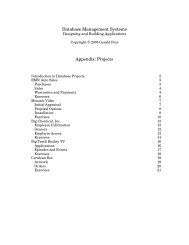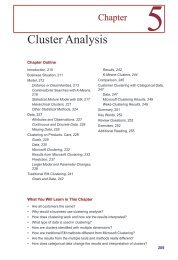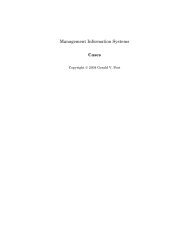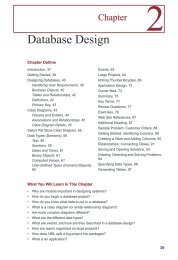Database Projects/5e - Professor Jerry Post
Database Projects/5e - Professor Jerry Post
Database Projects/5e - Professor Jerry Post
Create successful ePaper yourself
Turn your PDF publications into a flip-book with our unique Google optimized e-Paper software.
Pliable Plastic Production (2010)<br />
Project Descriptions<br />
To an economist, manufacturing seems like such a simple concept: Buy some<br />
equipment (capital), purchase a bunch of raw materials (inputs), hire some workers<br />
(labor), and make a product. Refine the process and drive down costs, make<br />
enough products and sell them at high enough prices to cover the fixed and marginal<br />
costs. Today’s manufacturing is more complex—even for relatively small<br />
shops. Flexibility is critical to most manufacturers—particularly those who focus<br />
on custom products. This company specializes in molding and fabricating plastic<br />
items—and many of the things you buy today use plastic components. Entrepreneurs<br />
who invent new products typically require many plastic components. All<br />
of these have to be designed, custom molds built, and the factory has to schedule<br />
inputs and production time on the machines. The goal of this case is to build a database<br />
that helps track the main steps of design, purchase, and production.<br />
Design<br />
The first step in creating a new product is to design it. In terms of production of<br />
plastic parts, design consists of detailed diagrams of the product along with molds<br />
and various extrusion techniques. The type of plastic also needs to be specified<br />
because each type has different levels of hardness, flexibility, and strength. For a<br />
moment, think about a small plastic box with an attached lid and snap clasp. With<br />
the proper equipment, this box can be produced in one piece by extrusion—pushing<br />
plastic through a set of molds that shape and contour each element of the box.<br />
The key lies in the design and then building a prototype to test and refine the design.<br />
In a custom shop, the designs are provided by outside companies who need<br />
the product.<br />
Figure 1 shows the basic data needed regarding a design. Typically, designs<br />
go through several versions—both during prototyping and once production starts.<br />
Product ID<br />
Description<br />
Approximate Size:<br />
height, width, depth<br />
Primary material<br />
Customer<br />
Contact Person<br />
Phone<br />
E-mail<br />
Address<br />
City, State, <strong>Post</strong>al Code<br />
Country<br />
Version Date File Comments<br />
Input Quantity per<br />
1000 units<br />
Figure 1<br />
Vendor Message<br />
Commands<br />
43







